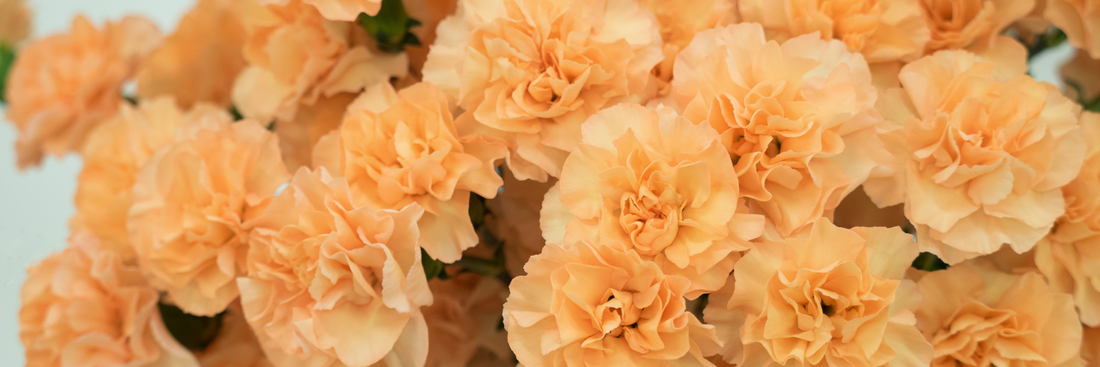The ruffled, delicate petals of the ubiquitous carnation are familiar the world over. They are beautiful and timeless, and one of the world’s oldest cultivated flowers. In fact, after roses, carnations are said to be the world’s most popular flower.
The Flower Farm has been the home of fresh flowers in Brisbane since the 1970s. It was then that the Sihota family started to grow and sell carnations at their Birkdale farm. And since we’ve become known for these stunning beauties. We’d say carnations are our signature flower!
So, today we’re taking a deep dive into all things carnations, to understand their meaning, enduring popularity and appeal.
The Flower Farm – first in Brisbane with carnations

The original Flower Farm owners Tarsem and Harbans Sihota, moved to the Redlands area in 1978. They initially established a strawberry farm in Birkdale, growing and selling strawberries to markets in Brisbane and Sydney.
The Sihotas progressed to growing and selling carnations and chrysanthemums. They were the first to sell fresh flowers at the Brisbane markets, so the (then) Queensland Department of Primary Industries helped to set their first price – $2 a bunch!
Word soon spread that The Flower Farm was the home of carnations in Brisbane.
Carnations – origin

The scientific name for carnations is Dianthus caryophyllus. Carnations were named by Athenians, from the Greek words dios (divine) and anthos (flower) – so were said to be ‘flowers of the gods’.
Carnations are believed to have originated in the Pyrenees as single-flowered specimen. And the wild carnation is native to Greece, Italy, Spain and other Mediterranean countries. They have been cultivated for the last 2,000 years to become the beautiful blooms you find worldwide today.
Today you can find these perennial fringed flowers in a huge variety of colours, such as yellow, pink, white, red, purple and even green. The wide variety of colours and shades, as well as their longevity as cut flowers and their ease of cultivation have combined to make them universally popular round the world.
Carnations in Australia

In Australian carnations were long overlooked in the flower-giving world. With enduring meanings of love associated with carnations, it’s no wonder they have steadily grown in popularity. They are finally being appreciated as a starring-flower, stepping out of their ‘supporting-flower’ role in bouquets and arrangements. Just take a look at our Special Seasonal Carnation Mix Bunch that overflows with colour, consisting of beautiful blooms we pick daily, straight from our farm fields.
Association with Mothers’ Day
Carnations have been associated with Mothers’ Day since 1908. In May of that year, Anna Jarvis caused a stir when she sent hundreds of white carnations (her late mother’s favourite flower) to her home-town church in the American state of West Virginia. Within five years, nearly every state in America honoured mothers on the second Sunday in May.
The white carnation was originally associated with Mothers’ Day. This later changed to red and pink carnations representing a living mother, and white carnations honouring mothers who had passed away.
Colours
As with so many other flowers, different coloured carnations carry different meanings. Let’s look at a few:

-
Pink carnations are very popular for Mothers’ Day, as they symbolise a mother’s undying love. Over time, pink carnations have also come to represent gratitude, so can be sent to say, ‘thank you’.
-
Red carnations symbolise love, admiration and affection.
-
White carnations mean pure love, similar to a mother’s love. They have also come to mean good luck, loyalty, innocence and faithfulness.
- Yellow carnations have a sad sentiment attached to them. They are said to represent rejection or disappointment, so historically have been sent as a ‘break up’ flower.
Best time to give carnations
At The Flower Farm, we believe that every day is a great day to send carnations! To give you a little more clarity surrounding popular times to send carnations though, here’s a little food for thought:
-
Carnations are a birth month flower for those born in January, so our Special Seasonal Carnation Mix Bunch is a great ‘happy birthday’ choice!
-
As red carnations symbolise love, admiration and affection, they are the perfect choice to say ‘I love you’ at any time of year – why wait for Valentine’s Day?
-
Carnations are the traditional flowers to send for a first wedding anniversary. A bespoke bouquet in pink or red (or a combination of the two!) would be a lovely choice. Get in touch with our florists at The Flower Farm – we’d love to create the perfect carnation bouquet for you.
-
It’s no surprise that we’ll say that Mothers’ Day is a great time to send carnations. The week leading into Mothers’ Day is our busiest of the year at The Flower Farm. White and pink carnations are enduring favourites to send for Mothers’ Day, or for a new Mum.
- White carnations are a popular choice to give or send to celebrate graduations or for those starting on a new path in life.
Caring for carnations – keeping them fresh

Carnations remain fresh as cut flowers for seven to 14 days. Our post on How to Care for Cut Flowers gives you all the care tips you need to maximise the vase-life of your carnations and enjoy them for as long as possible.
We hope you have enjoyed our focus on carnations – our sentimental favourite flower. Get in touch with us at The Flower Farm, or call in and see us at the shop. We’d love to create a bespoke bouquet or arrangement just for you.

